Table of Contents
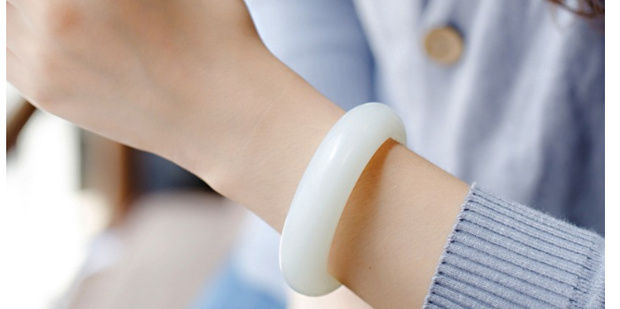
1. Introduction: Why Bracelet Size Matters
When it comes to buying or gifting a bracelet, many people focus on the design, material, or brand. However, few realize that one of the most important aspects of wearing a bracelet comfortably and stylishly is selecting the right size. Learning how to measure bracelet size is essential—not just for comfort, but also to ensure the piece complements your wrist perfectly and lasts for years without wear or damage.
A bracelet that is too tight can restrict movement, cause discomfort, and even lead to breakage over time. On the other hand, a bracelet that’s too loose can easily slip off or twist around, detracting from its appearance and practicality. Especially when purchasing bracelets online, getting the size right the first time is crucial to avoid costly returns or resizing issues.
Proper bracelet sizing also enhances the aesthetics of the jewelry. A well-fitting bracelet sits naturally on the wrist, drawing attention to its craftsmanship and design. It becomes an effortless extension of your personal style, whether you’re dressing up for an event or wearing it casually.
Beyond comfort and beauty, the right bracelet size can even influence the longevity of the piece. Ill-fitting bracelets are more prone to stretching, snapping, or wearing unevenly—especially if they are made of delicate materials like beads, elastic, or thin chains.
That’s why understanding how to measure bracelet size accurately is a foundational step in the jewelry-buying process. Whether you’re shopping for yourself or someone else, knowing the correct measurement makes all the difference between a cherished accessory and a frustrating experience.
2. Understanding Bracelet Sizes
Before diving into the different ways of how to measure bracelet size, it’s helpful to understand how bracelet sizing actually works. Bracelets are typically sized based on wrist circumference, and the fit preference—snug, comfort-fit, or loose—determines the final bracelet length.
📏 Standard Bracelet Size Ranges
Bracelet sizes are generally measured in inches or millimeters and can vary depending on the country, brand, or style. Here’s a breakdown of common size ranges used globally:
| Size Label | Wrist Circumference (inches) | Bracelet Length (inches) | Millimeter Equivalent (mm) |
|---|---|---|---|
| Extra Small (XS) | 5.0″ – 5.5″ | 5.5″ – 6.0″ | 127 – 140 mm |
| Small (S) | 5.5″ – 6.0″ | 6.0″ – 6.5″ | 140 – 152 mm |
| Medium (M) | 6.0″ – 6.5″ | 6.5″ – 7.0″ | 152 – 165 mm |
| Large (L) | 6.5″ – 7.0″ | 7.0″ – 7.5″ | 165 – 178 mm |
| Extra Large (XL) | 7.0″ – 7.5″ | 7.5″ – 8.0″ | 178 – 203 mm |
📌 Note: The actual bracelet size you need is usually 0.5 to 1 inch (12–25mm) larger than your wrist measurement, depending on the desired fit.
💡 Small, Medium, or Large: What Does It Mean?
- Small wrists usually measure below 6 inches (152mm) in circumference and suit delicate, thin bracelets or bangles.
- Medium wrists, ranging between 6 and 7 inches (152–178mm), are the most common and fit standard bracelet sizes.
- Large wrists, above 7 inches (178mm), require longer or adjustable bracelets for optimal comfort.
Keep in mind that different bracelet types (e.g., bangles vs. chain bracelets) have their own unique sizing considerations. A bangle, which must slide over the hand, often requires a slightly different measurement than a flexible chain bracelet.
Understanding these categories will help you better interpret size charts and decide which measurement method to use in the next steps. Whether you’re choosing a statement cuff or a dainty beaded bracelet, knowing your wrist size and preferred fit is the first step toward ensuring it feels as good as it looks.
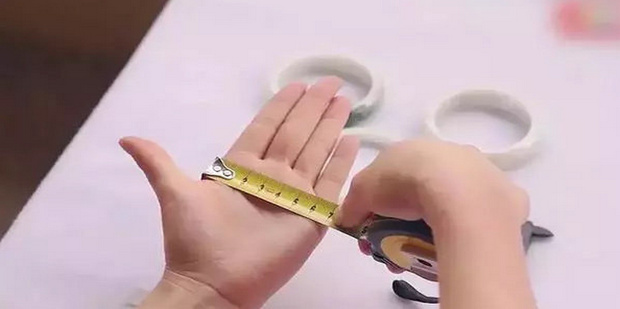
3. How to Measure Bracelet Size at Home
Measuring your bracelet size at home is easier than you might think, and it’s a crucial step to ensure you get a comfortable and flattering fit. Whether you have a soft measuring tape or not, there are several practical ways to measure your wrist accurately. Knowing how to measure bracelet size correctly helps avoid the frustration of ordering the wrong size online or receiving an ill-fitting gift.
Below are three popular and reliable methods you can use at home to determine your wrist size and subsequently your ideal bracelet size.
3.1 Using a Soft Measuring Tape
A soft measuring tape, often used for sewing or tailoring, is the most straightforward tool for measuring your wrist.
Step-by-step:
- Wrap the soft measuring tape snugly around the wrist at the point where you would normally wear a bracelet.
- Make sure the tape lies flat against the skin but isn’t too tight to restrict movement.
- Note the measurement where the tape meets the zero point.
- This measurement is your wrist circumference in inches or millimeters.
If you want your bracelet to fit comfortably, add 0.5 to 1 inch (12 to 25 mm) to this measurement to allow for movement and layering.
3.2 Using a String and Ruler
If you don’t have a soft measuring tape, this method is a handy alternative.
Step-by-step:
- Take a non-stretchable string and wrap it around your wrist at the bracelet position.
- Mark the point where the string overlaps.
- Lay the string flat and measure the length up to the marked point using a ruler.
- Add your preferred allowance for comfort (usually ¼ inch to 1 inch depending on fit).
This method is easy to do and requires only household items, making it one of the best ways to learn how to measure bracelet size without special tools.
3.3 Using an Existing Bracelet as Reference
If you already own a bracelet that fits well, measuring it can save you guesswork.
Step-by-step:
- Lay the bracelet flat on a surface with the clasp closed.
- Use a ruler or measuring tape to measure its total length from end to end.
- This length equals the size of the bracelet.
- Use this number as your guide when buying new bracelets.
Keep in mind that different bracelet styles may fit differently, so consider the type of bracelet when using this method.
4. Wrist Size vs. Bracelet Size: What’s the Difference?
Understanding the difference between your wrist size and the bracelet size you need is essential to get a comfortable and well-fitting piece.
- Wrist size refers to the exact circumference of your wrist where you wear your bracelet.
- Bracelet size is the total length of the bracelet, which includes your wrist size plus some extra space for comfort and movement.
How to Convert Wrist Size to Bracelet Size
When you know your wrist circumference, you generally want to add some allowance to determine the right bracelet size. The amount of allowance depends on how you prefer your bracelet to fit:
- Snug Fit: Add about ¼ inch (6 mm) to your wrist size. This fit is close to the skin and less likely to move around.
- Comfort Fit: Add ½ inch (12 mm). This is the most popular fit, allowing some movement without slipping.
- Loose Fit: Add ¾ to 1 inch (18–25 mm). Ideal for stacking multiple bracelets or for those who prefer more freedom of movement.
Why This Matters
Buying a bracelet that matches your wrist size exactly without any allowance will likely feel too tight and uncomfortable. Conversely, too much allowance may cause the bracelet to slide off or get in the way.
By understanding how to measure bracelet size properly and knowing the difference between wrist size and bracelet size, you can select bracelets that not only look great but also feel comfortable throughout the day.
5. Bracelet Sizing Tips for Different Bracelet Types
Different bracelet styles have unique fitting characteristics and sizing requirements. Understanding how to measure bracelet size based on the specific type can help ensure the perfect fit, enhance comfort, and preserve the bracelet’s integrity over time. Below we explore sizing tips for common bracelet styles including bangles, cuffs, chain or clasp bracelets, and beaded/stretch bracelets.
5.1 Bangle Bracelets
Bangles are rigid, circular bracelets that must slide over your hand to fit around your wrist. Because they don’t open or adjust, accurate measurement is essential when learning how to measure bracelet size for bangles.
- Measure the widest part of your hand (usually across the knuckles) rather than just the wrist circumference. This is because the bangle must pass over the hand to sit comfortably on the wrist.
- To measure, wrap a soft tape or string around your hand’s widest point and convert that to the corresponding bangle diameter.
- Ensure the bangle’s inner diameter is slightly larger than this measurement for easy wear.
- Bangle bracelets are often sized by inner diameter in millimeters or inches, so refer to sizing charts carefully.
5.2 Chain or Clasp Bracelets
Chain bracelets and those with clasps offer more flexibility as they can be adjusted to fit snugly or loosely.
- When measuring for chain bracelets, focus on your wrist circumference plus allowance for comfort.
- Since clasp bracelets can often be fastened at multiple points, a tighter fit is possible without discomfort.
- Consider whether you want room for layering with other bracelets; if yes, add extra length when calculating size.
- Measuring your wrist with a soft tape or string, then adding ½ inch (12 mm) is generally a safe rule of thumb for chain bracelets.
5.3 Cuff Bracelets
Cuff bracelets are usually open-ended and can be gently adjusted to fit.
- For cuffs, the key measurement is your wrist circumference, but because cuffs don’t fully encircle the wrist, they often feel less restrictive.
- When measuring, choose a size that matches or is slightly larger than your wrist measurement.
- Keep in mind that frequent bending can weaken the metal, so avoid over-adjusting.
- A cuff that’s too large may slip off easily, so precise measurement is important.
5.4 Beaded and Stretch Bracelets
Beaded and stretch bracelets use elastic or flexible materials, providing a forgiving fit.
- Although stretch bracelets accommodate various wrist sizes, it’s still important to measure your wrist circumference for comfort.
- For beaded bracelets, measure your wrist with a soft tape and consider your preference for fit tightness.
- Keep in mind that elastic can lose tension over time, so a slightly snug fit initially is ideal.
- When ordering, select the size closest to your wrist measurement without adding much extra length.
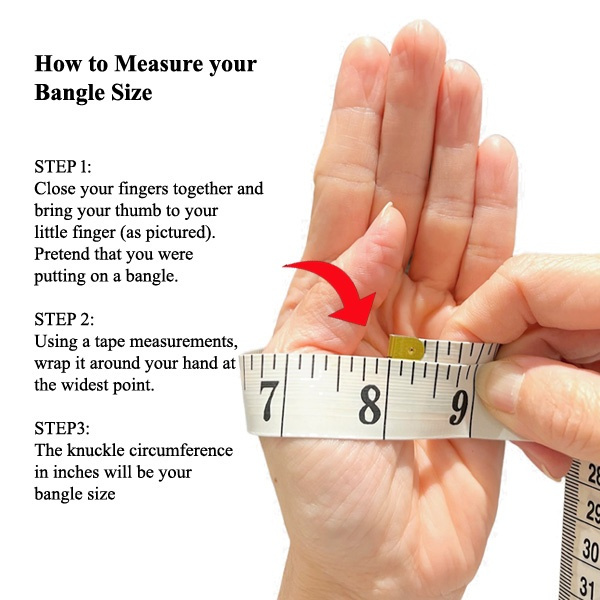
6. Bracelet Size Chart (in Inches and Millimeters)
To make the process of how to measure bracelet size even easier, here is a comprehensive size chart that matches wrist circumferences to recommended bracelet lengths. This reference helps you select the perfect size whether shopping online or in-store.
| Wrist Circumference (inches) | Wrist Circumference (mm) | Recommended Bracelet Size (inches) | Recommended Bracelet Size (mm) | Notes |
|---|---|---|---|---|
| 5.0 – 5.5 | 127 – 140 | 5.5 – 6.0 | 140 – 152 | Extra Small / Petite |
| 5.5 – 6.0 | 140 – 152 | 6.0 – 6.5 | 152 – 165 | Small |
| 6.0 – 6.5 | 152 – 165 | 6.5 – 7.0 | 165 – 178 | Medium (Most Common) |
| 6.5 – 7.0 | 165 – 178 | 7.0 – 7.5 | 178 – 190 | Large |
| 7.0 – 7.5 | 178 – 190 | 7.5 – 8.0 | 190 – 203 | Extra Large |
| 7.5+ | 190+ | 8.0+ | 203+ | Oversized / Custom Fit |
How to Use This Chart:
- First, measure your wrist circumference using one of the methods discussed earlier.
- Next, decide your preferred fit (snug, comfort, or loose) and add the corresponding allowance to your wrist measurement.
- Then, consult the chart to find the recommended bracelet size that matches your adjusted measurement.
- Use this size when ordering bracelets to ensure a perfect fit.
Final Note:
Mastering how to measure bracelet size is key to finding jewelry that feels as good as it looks. By understanding the nuances of different bracelet types and consulting accurate size charts, you’ll avoid common pitfalls and enjoy your bracelets for years to come.
7. Bracelet Size Guide for Men, Women, and Children
When learning how to measure bracelet size, it’s essential to consider the wearer’s gender and age because wrist sizes vary significantly between men, women, and children. Properly understanding these differences helps ensure you get the perfect fit. Each group has typical size ranges and preferences that directly influence the ideal bracelet size for comfort, style, and ease of wear. Mastering how to measure bracelet size for different groups guarantees a better wearing experience.
7.1 Men’s Bracelet Size Guide
Men typically have larger and thicker wrists than women, so when you’re learning how to measure bracelet size for men, remember their sizes usually range from medium to extra-large.
- Average wrist circumference for men is about 7 to 8 inches (178 to 203 mm).
- The recommended bracelet length for men typically ranges from 7.5 to 9 inches (190 to 229 mm).
- Men’s bracelets tend to be wider and chunkier to match their wrist size and style preferences.
When measuring, always add about ½ to 1 inch (12 to 25 mm) for comfort and layering multiple bracelets. This allowance is important in how to measure bracelet size correctly for men, to avoid a fit that’s too tight or restrictive.
Tip: For men who prefer a snug fit, add ½ inch allowance when you measure; for a loose fit, add 1 inch to the wrist circumference.
7.2 Women’s Bracelet Size Guide
Women’s wrists are generally smaller and more delicate, so understanding how to measure bracelet size for women is critical to achieving the right balance between comfort and aesthetics.
- Average wrist circumference for women ranges from 6 to 7 inches (152 to 178 mm).
- Recommended bracelet length for women is usually between 6.5 to 7.5 inches (165 to 190 mm).
- Women’s bracelets often feature finer designs and thinner chains or bangles.
When measuring for women, add ¼ to ½ inch (6 to 12 mm) depending on how tight or loose they want the bracelet to fit. Proper allowance is key when learning how to measure bracelet size for women to ensure it’s neither too tight nor too loose.
Tip: For a classic, comfortable fit, adding ½ inch allowance works best.
7.3 Children’s Bracelet Size Guide
Children’s wrists vary widely by age, so knowing how to measure bracelet size for children is especially important when buying bracelets for kids.
Typical wrist circumference by age group is:
- Toddlers (1-3 years): 4.5 to 5 inches (114 to 127 mm)
- Young children (4-7 years): 5 to 5.5 inches (127 to 140 mm)
- Older children (8-12 years): 5.5 to 6 inches (140 to 152 mm)
Children’s bracelets are usually adjustable or stretchy to accommodate growth. When measuring kids, always allow extra room—typically about ½ inch (12 mm)—for comfort and future growth. This extra allowance is crucial to how to measure bracelet size correctly for children.
Tip: Stretch bracelets are a great choice for children due to their flexibility and ease of wear, making the sizing process more forgiving.
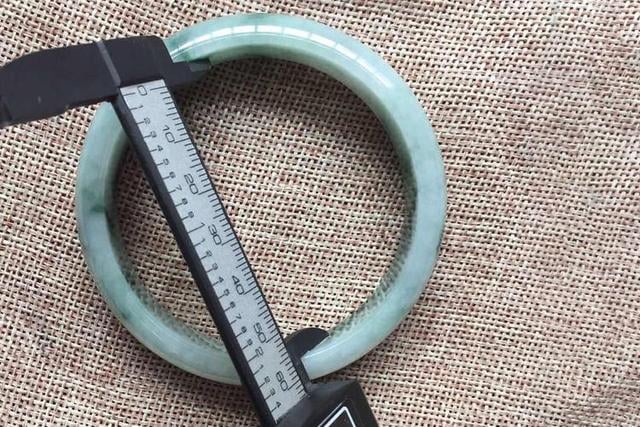
8. International Bracelet Size Conversion Table
Shopping for bracelets internationally can be confusing due to different sizing systems used around the world. To simplify your purchase, here is a comprehensive conversion table to translate US bracelet sizes to UK, EU, and Asian measurements. Knowing these conversions will help you confidently order the correct size no matter where you shop.
| US Size (inches) | UK Size (inches) | EU Size (cm) | Asia Size (mm) | Description |
|---|---|---|---|---|
| 6.0 | 6.0 | 15.2 | 152 | Small (Women) |
| 6.5 | 6.5 | 16.5 | 165 | Medium (Women) |
| 7.0 | 7.0 | 17.8 | 178 | Medium-Large (Women/Men) |
| 7.5 | 7.5 | 19.1 | 190 | Large (Men) |
| 8.0 | 8.0 | 20.3 | 203 | Extra Large (Men) |
| 8.5 | 8.5 | 21.6 | 216 | Oversized |
How to Use This Table:
- Measure your wrist circumference using one of the methods previously described.
- Identify your US bracelet size in inches.
- Use the table to find the equivalent size in your region’s sizing system.
- This is especially helpful when shopping on international websites that use different sizing conventions.
Why This Matters for Global Shoppers
Understanding how to measure bracelet size and then translating that measurement across different international sizing standards helps prevent ordering mistakes. For example, a US medium size bracelet might correspond to a slightly different measurement in the EU or Asia, and using this table ensures you select the right one.
Final Tip: Always double-check the seller’s sizing guide when shopping internationally, as some brands may have unique sizing conventions.
9. Common Mistakes to Avoid When Measuring Bracelet Size
Measuring your bracelet size might seem straightforward, but small mistakes can lead to uncomfortable fits or costly returns. Understanding these pitfalls is essential when learning how to measure bracelet size properly, helping you get it right the first time. Here are some common errors to avoid when learning how to measure bracelet size:
9.1 Measuring Too Tightly or Loosely
One of the most frequent mistakes in how to measure bracelet size is wrapping your measuring tape or string too tight or too loose around your wrist. A measurement taken too tightly will result in a bracelet that’s uncomfortable and difficult to put on. Conversely, a measurement taken too loosely may lead to a bracelet that slides off or feels bulky.
Tip: Measure your wrist with a relaxed hand and add the appropriate allowance depending on your preferred fit—snug, comfort, or loose. This step is vital in how to measure bracelet size correctly.
9.2 Forgetting to Add Allowance for Comfort
A common error during how to measure bracelet size is measuring your wrist exactly and ordering bracelets of the same size. Remember, the bracelet needs space to move slightly and not constrict your wrist.
Tip: Always add extra length (usually ¼ to 1 inch depending on your fit preference) to your wrist measurement to get the correct bracelet size. Adding allowance is crucial in mastering how to measure bracelet size effectively.
9.3 Ignoring Bracelet Style Differences
Not all bracelets fit the same way, so understanding how to measure bracelet size varies by style. For example, bangles need to fit over your hand, so measuring only the wrist circumference won’t suffice. Stretch bracelets are more forgiving than rigid metal cuffs.
Tip: Understand how different bracelet styles affect sizing and adjust your measurements accordingly. This knowledge is key when learning how to measure bracelet size for various bracelet types.
9.4 Using Inaccurate Tools
Using rigid rulers or stretchable strings can cause inaccurate measurements, leading to errors in how to measure bracelet size.
Tip: Use a soft, non-stretchable measuring tape or a non-elastic string combined with a flat ruler for best accuracy. Choosing the right tools is fundamental in precise how to measure bracelet size.
9.5 Measuring at the Wrong Spot
Your wrist’s circumference varies depending on where you measure it—above the wrist bone, at the wrist bone, or higher on the arm. This can cause confusion when learning how to measure bracelet size.
Tip: Measure where you plan to wear the bracelet, usually just below the wrist bone. Correct placement ensures accurate results in how to measure bracelet size.
9.6 Not Rechecking Measurements
Taking a single measurement without rechecking can cause errors due to wrist swelling or measurement inaccuracies, which impacts how to measure bracelet size.
Tip: Measure multiple times and use the average to ensure accuracy. Consistent measurement is a vital part of mastering how to measure bracelet size.
Avoiding these common mistakes will help you confidently select the perfect bracelet size, making your shopping experience smooth and satisfying. Mastering how to measure bracelet size accurately leads to better fitting, more comfortable, and stylish bracelets you’ll love to wear every day.
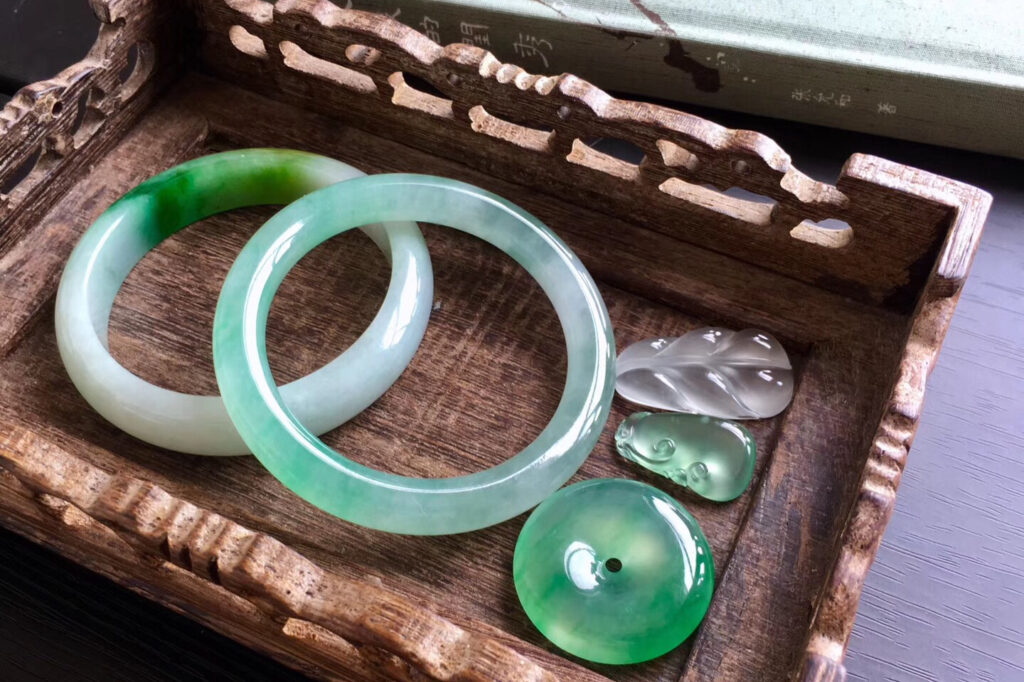
10. FAQ: Frequently Asked Questions About Bracelet Sizing
Below are answers to some of the most popular questions about how to measure bracelet size that shoppers often ask:
Q1: Can a bracelet be resized?
Answer:
It depends on the bracelet type. Metal chain or link bracelets can often be resized by adding or removing links. Bangles and cuff bracelets may be adjustable to some extent but resizing rigid bangles usually isn’t possible without damaging them. Always check with the seller or jeweler before purchasing if resizing is a concern.
Q2: What if I’m between sizes?
Answer:
If your measurement falls between two sizes, it’s generally best to size up for comfort. Adding extra length helps avoid tightness and allows for wrist movement and layering other bracelets. For adjustable bracelets like cuffs or chains with multiple clasp options, choose the size closest to your wrist circumference.
Q3: How tight should a bracelet be?
Answer:
A comfortable bracelet should fit snugly enough that it doesn’t slide off your wrist but loose enough to move slightly and not restrict blood flow. Typically, adding about ¼ to ½ inch (6 to 12 mm) to your wrist measurement achieves this balance. Personal preferences vary, so consider how you like your bracelets to feel during daily activities.
Q4: Can I use a regular tape measure or string?
Answer:
Yes, but make sure the tape or string is soft and non-stretchable. A rigid tape measure or elastic string can lead to inaccurate results. Using a soft tailor’s measuring tape is ideal.
Q5: How do I measure a bangle bracelet size?
Answer:
Measure the widest part of your hand (usually across the knuckles) with a soft tape or string to determine the inner diameter needed for the bangle to slip on comfortably. This measurement is different from your wrist circumference.
Q6: Are bracelet sizes universal?
Answer:
No, sizes can vary internationally. Refer to international conversion charts to find your size when shopping globally. Always check the seller’s sizing guide.
11.Conclusion: Get the Perfect Fit Every Time
Accurately knowing how to measure bracelet size is the key to enjoying your bracelets to the fullest. Whether you’re shopping online, buying a gift, or simply upgrading your collection, taking the time to measure your wrist correctly ensures that your bracelet will fit comfortably and look stunning.
A well-fitted bracelet not only enhances your style but also prevents common issues such as slipping off, pinching, or discomfort during daily wear. By using the right tools and methods—whether it’s a soft measuring tape, string and ruler, or referencing an existing bracelet—you can confidently select the perfect size every time.
Remember, different bracelet types require different measuring approaches, and adding the proper allowance based on your fit preference (snug, comfort, or loose) is essential for optimal comfort.
Investing a few minutes into mastering how to measure bracelet size will save you from costly returns, ill-fitting jewelry, and the hassle of guesswork. Embrace these tips and enjoy your jewelry as it was meant to be: a beautiful, comfortable, and meaningful accessory that complements your unique style.